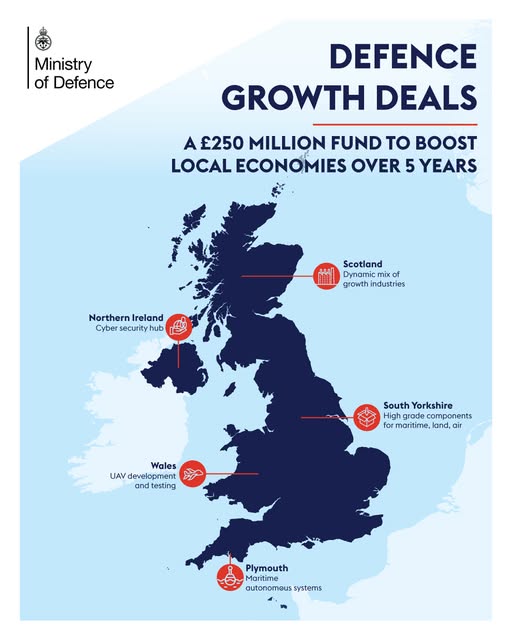A Guide to UK Ministry of Defence Strategy Documents and Policies – 2025/26
24.11.25


24.11.25

Whether your organisation is well established within the UK defence industry or plans to diversify and enter the market for the first time, having a strong understanding of the domestic government policies and MOD’s strategies and plans is critical for success. In this article, we explore key documents for strategic planning and engagement in UK defence.
With key papers, including the Defence Industrial Strategy, Strategic Defence Review (SDR), and Industrial Strategy, already in the public domain or soon to be, there is a wealth of tactical information available to businesses as they plan for 2026 and beyond.
Read on to find out more about the resources we recommend your organisation uses to align future business development objectives and marketing activities.
From informing overall organisational strategy right down to impacting the tactical delivery of key messages, documents such as the SDR should be considered at every level of your business.
Having a strong understanding of such resources will help your business to:
The key to success in using these documents to inform organisational thinking is to ensure that decisions made at a strategic level influence more tactical activities, right down to sales and marketing tactics. The whole company must be “bought in”, with coherent and consistent messaging used throughout.
Published in September – just before DSEI 2025 – the Defence Industrial Strategy outlined how HM Government, the MOD, and industry will collaborate to achieve six key priorities:
Throughout the strategy there is a focus on national development via five regional Defence Growth Deals, which will see £250 million shared between a selection of regional economies:

Key areas of interest for sales and marketing teams: The Defence Industrial Strategy doesn’t just outline the myriad of opportunities for already well-established defence and security organisations, but also highlights the important contribution that can be made to defence innovation by new and emerging businesses, with Defence Secretary, John Healey MP stating that HM Government wants “to make the UK the best place in the world to start and grow a defence firm”.
Start-ups, or businesses looking to diversify into defence for the first time, should ensure that their business objectives take this into account and that their strategic marketing, communications, and PR reflect how they can support and develop their local defence economy with real-life tangible benefits.
“The recent announcement of the largest sustained increase to defence spending since the Cold War – rising to 2.5% of GDP in 2027 and 3% in the next Parliament – is crucial for our national security.
“Alongside this significant investment, must come serious reform: we must also make vital reforms to speed up our decision making, focus on outcomes, secure faster delivery and achieve the best value for money for taxpayers.” Rt Hon John Healey MP, Secretary of State for Defence.
Published on 2 June, The Strategic Defence Review 2025 – Making Britain Safer: Secure at Home, Strong Abroad sets out the UK Government’s plan to strengthen European security, modernise the Armed Forces, and support global stability.
The SDR commits to greater investment in uncrewed and naval systems, backed by over £4 billion for autonomous technologies to shape the UK’s future military and expand export potential. It also confirms the construction of 12 new attack submarines, reinforcing Britain’s maritime power and deterrence capability.
Prioritising nuclear deterrence, hybrid air and naval systems, and AI-enabled land and air forces, the SDR positions the UK to lead NATO in technological innovation and procurement agility. Its core technology pillars include:
These pillars ensure the UK warfighter remains ready, agile, and equipped for potential future conflicts.
Key areas of interest for sales and marketing teams: In addition to the focus on harnessing new technologies – including drone and laser weapons – to develop both conventional and digital warfighters, the SDR also signals an intended cultural change through the “whole-of-society approach”, which aims to foster strong ties between the nation’s public and those who serve. The document highlights the importance of breaking down barriers between the military and the private sector.
Therefore, organisations seeking to capitalise on defence spending in the coming years should ensure their messaging reflects their support for and collaboration with the UK’s armed forces.
The release of the Defence Investment Plan is imminent. It is expected to be published around the Autumn Budget which will be delivered on Wednesday 26 November.
The expectation is the plan will set out how the SDR will be delivered and provide a clear signal of the UK’s defence procurement, innovation, and technology intent for the next decade.
Current indications suggest that the upcoming Defence Investment Plan will cover the infrastructure needed to deliver the SDR, how flexible procurement will allow for adaptation of new and emerging technologies, and how the government’s investment will deliver warfighting readiness.
Key areas of interest for sales and marketing teams: We expect to see updates on major programmes, including the long-awaited New Medium Helicopter project . Furthermore, there will be details on the streamlining of procurement modernisation, which will include delivering value for money through market segmentation, digitally enabled acquisition, and simplify decision-making.
In June 2025, the UK Government unveiled its Modern Industrial Strategy, outlining a ten-year plan to boost investment and sustainable growth across key sectors including aerospace, advanced manufacturing, digital technology, and defence.
The strategy – the 11th of its kind in the past 13 years under successive governments – stems from extensive consultation that began with the Invest 2035 green paper, launched in October 2024, which sought to gather industry perspectives on long-term industrial development.
Positioned as a vehicle for collaboration between government and industry, the strategy and the resulting industrial sector plans aim to help businesses generate wealth through innovation, partnerships, and targeted enterprise support.
Key areas of interest for sales and marketing teams: The Modern Industrial Strategy identifies eight key sectors that offer significant growth opportunities over the next decade and will be crucial in supporting economic security and resilience, achieving net zero, and driving regional growth: advanced manufacturing; clean energy industries; creative industries; defence; digital and technologies; financial services; life sciences; and professional and business services.
Companies within these sectors should focus on collaborative opportunities with businesses in other identified industries and include key messages and themes in their marketing that demonstrate how their products and/or services can be adapted and adopted across these key areas highlighted by government.
ADS is the UK trade association representing the aerospace, defence, security, and space sectors. Within itsrecentADS UK Defence Sector Outlook, the trade bodyprovides an objective summary of the opportunities and threats within the UK defence industry and is a useful resource on which to consider future sales, business development, and marketing and communications strategies.
The report, released in June to coincide with the government publications, highlights three potentially challenging areas that the UK defence industry must seek solutions for:
Key areas of interest for sales and marketing teams: The Outlook identifies several key industry implications and how these can provide opportunities for defence and security organisations. The UK’s ability to map and source critical materials and minerals will be of utmost importance, so organisations that can support this area should be making this a key strategic business objective and explicitly communicating how they can address the difficulties the government currently faces.
Building partnerships with non-traditional suppliers will be key to the government’s aim to maximise emerging technologies. Therefore, companies looking to see their products adopted within the industry should focus on messaging that shows how compatible and adaptable their technology is to defence requirements.
Taken together, these strategies, reviews, and industry outlooks provide a clear signal that the UK defence landscape is entering a period of accelerated investment, technological transformation, and deeper collaboration between government, industry, and emerging innovators. For organisations already operating in the sector—as well as those seeking to diversify into it—success will depend on the ability to align corporate objectives, product development, and market positioning with the MOD’s stated priorities and long‑term direction of travel.
Those that understand and apply the insight contained within these documents will be better placed to identify growth opportunities, shape propositions around genuine capability needs, and communicate in a way that speaks the language of defence stakeholders. From strategic planning to day‑to‑day sales and marketing execution, coherent messaging and organisational alignment will be essential to standing out in an increasingly competitive and rapidly evolving market.
By embedding these frameworks into business development, communications, and engagement activity now, organisations will not only be better prepared for procurement cycles ahead, but also demonstrate credibility, relevance, and readiness in supporting the UK’s future defence and security requirements.


Signatories of:


Members of:



Innovation House
Molly Millars Close
Wokingham
RG41 2RX